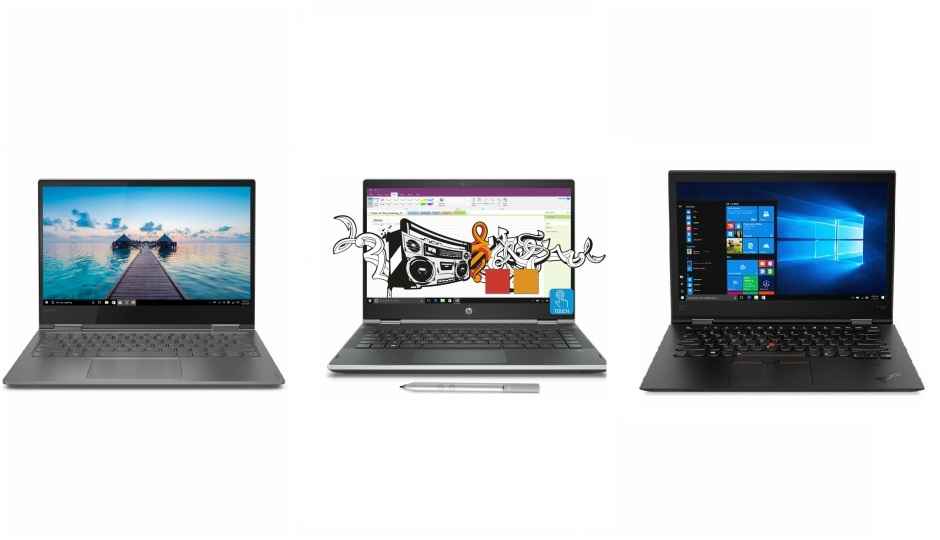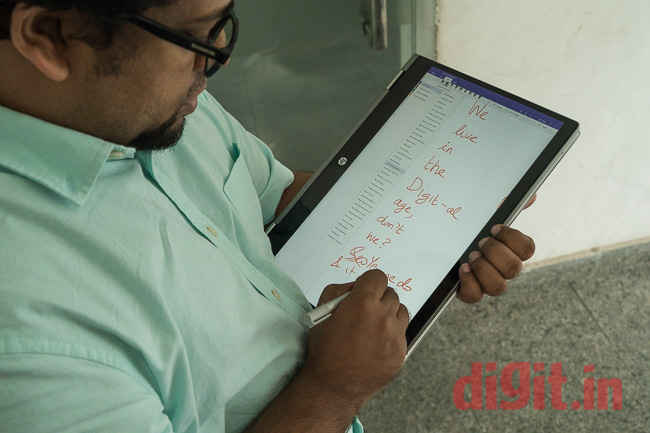Convertible Laptops Comparo: Lenovo Yoga 730 vs HP Pavilion x360 vs ThinkPad X1 Yoga
We pit the Lenovo Yoga 730, the HP Pavilion x360 and the ThinkPad X1 Yoga against each other to find out which convertible might best suit your needs. Read on to find out.

In the last few months, I’ve had the opportunity of testing three distinctly different convertible laptops across three different price ranges. The first was the Lenovo ThinkPad X1 Yoga, the third-generation model in the popular line of business convertibles by Lenovo. The second was the more pocket-friendly Lenovo Yoga 730, which was a mild refresh over the existing Yoga 720. The last was the most affordable convertible of the three, the HP Pavilion x360. It’s essentially last year’s Spectre x360 resurrected as a Pavilion to offer more value for money.
 Survey
SurveyNow that I’ve tested the three, let’s pit them against a standard set of parameters to review how they performed. We expect to learn which was the best in each parameter through this article. Off we go:
Performance
In the performance department, all the three convertible laptops are powerful enough for everyday use even when the number of applications in the taskbar tips over eight. That said, the ThinkPad X1 Yoga outright excels in terms of processing speed, while the Yoga 730 trumps the other two in data read-write speeds. The review unit of the Pavilion x360 we had employed a 128GB SSD along with a 1TB hard drive. This made the laptop lose out on speed points, but not by much. Booting and application launches were still acceptably fast. The presence of a hard drive also made the device heavy to carry around by tens of grammes.
The review units of the ThinkPad X1 Yoga and the Yoga 730 carried NVMe SSDs, which made booting, file transfer, and application launches blazing fast. If I had to recommend one of the three in terms of performance alone, I’d recommend the Lenovo Yoga 730, with the ThinkPad X1 Yoga being my second choice.
Display
All three convertible laptops feature a Full HD IPS display with touch support. The ThinkPad X1 Yoga has an optional WQHD display that has a resolution of 2560 x 1440 pixels. That, on the review unit, made colours appear overly saturated. Brightness, however, was available in plenty—270 nits of it in fact. The Yoga 730’s Full HD IPS unit shows colours more accurately and brightly. The Pavilion x360’s unit is bright enough for most indoor and outdoor spaces but doesn’t achieve the same level of colour accuracy as the other two. In fact, the 14-incher achieves only 63 percent of the sRGB colour space.
The writing and drawing experience is the best on the Lenovo Yoga 730 and decent on the Pavilion x360. The review unit of the ThinkPad X1 Yoga sadly could not be tested for pen input but seemed to have a responsive touchscreen nonetheless. Among the three, only the ThinkPad has an inbuilt silo for storing the stylus. Pen inputs on the Pavilion x360 happen with a little bit of latency, and the space between the top-most surface of the display and the screen is high. So, some parallax can be expected from it.
Writing and drawing on the Yoga 730 is a pleasant experience
In terms of the sturdiness of hinges, the Lenovo Yoga 730 scores top marks. Its hinges are built solidly and are tight enough for bumpy aeroplane rides. The display stands erect and doesn’t shake or jerk about when the laptop is moved around. The ThinkPad X1 Yoga is the next tightest in this regard, and the Pavilion x360, the loosest. The ThinkPad comes with a sophisticated mechanism by which the keys on the keyboard retract to sit flush with the body when the laptop is folded back into tablet mode. It’s this sort of sophistication that pushes the ThinkPad’s price tag all the way beyond one lakh, fifty thousand rupees.
Portability
Among the three, the Lenovo Yoga 730, weighing only 1.12 kilogrammes, is the thinnest and the lightest. It has an appropriately sized 13.3-inch display and a slender body, which is ideal for both intensive work and portability. The next lightest is the ThinkPad X1 Yoga. At 1.4 kilogrammes, the ThinkPad is slightly heavier but the weight isn’t noticeable considering its overall dimensions. Also, its slightly larger display makes it slightly less portable than the Yoga 730. The Pavilion x360 is the heaviest of the three, at 1.59 kilogrammes. It’s heavier partly because of its more substantial body and its 2.5-inch hard drive.
The HP Pavilion x360 weighs the most among the three, partly because of its hard drive
In terms of overall build, the ThinkPad X1 Yoga is ahead of the other two by miles, thanks to its hybrid carbon fiber body that's tested to MIL-SPEC standards. The Yoga 730 comes second with its aluminium cover and strong metallic hinges. The Pavilion x360 uses a plastic body that gives into the pressure of strong finger holds easily. Nevertheless, it'll survive a rare scratch or two.
Battery Life
The ThinkPad X1 Yoga takes the cake on this one, almost as expected because ThinkPads are known for long battery life. During my tests, the review unit lasted somewhere between 6 and 7 hours on a single charge with mixed usage. On the standard benchmark test, it scored a chart-topping 281 hours. Expect about 8 hours on a single charge with moderate usage. It’s definitely got the best battery of the three here.
The HP Pavilion x360 scored 185 minutes on the standard benchmark test. Even with its old-school hard drive, the review unit managed 6 hours in real-world-usage scenarios. Expect the Pavilion x360 to return at least 6 hours with moderate usage. It’s not the best, but it’s not the worst either. And its score is acceptable, given that the laptop costs less than a lakh rupees to buy.
The Lenovo Yoga 730 scored 157 minutes in the standard benchmark test. With real-world usage, the review unit lasted me less than 5 hours on a single charge on numerous occasions. This, for a convertible laptop, is below par. Expect no more than 5 hours on the Yoga 730 even with moderate usage.
Summary
The ThinkPad X1 Yoga costs over one lakh, fifty thousand rupees. At that price, it offers great quality and sophistication but you needn’t pay that much if you’re only interested in the convertible-laptop essentials. The HP Pavilion x360 starts at a little over seventy thousand rupees and gets all the basics right. It’s an ideal laptop if you’re entering the world of convertible laptops and want to write and draw freehand. If, however, you can spend some more, I’d suggest the Lenovo Yoga 730. It costs a little over a lakh rupees to buy, but it’s the laptop that offers the most bang for your buck. It’s also the thinnest and lightest among the three, something that’s crucial when you want a portable electronic slate.
Follow the links to read full reviews of the Lenovo ThinkPad X1 Yoga, the HP Pavilion x360, and the Lenovo Yoga 730.
Vignesh Giridharan
Progressively identifies more with the term ‘legacy device’ as time marches on. View Full Profile

